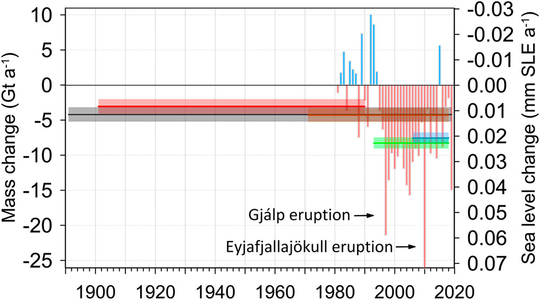New article on glacier changes in Iceland over the past 130 years
A scientific article by Icelandic glaciologists is an important contribution to global studies and assessments of climate change. The average mass loss of the Icelandic glaciers per unit area in recent decades is among the highest on Earth.
An article recently published in the journal Frontiers in Earth Science on glacier changes in Iceland describes changes in the volume and mass of the Icelandic glaciers since they reached historical maximum extent at the end of the so-called Little Ice Age shortly before 1900. The results of a number of studies covering about 99% of the glacier area are summarized in the article, which is a collaborative effort of many glaciologists at several institutes that conduct measurements and research on glaciers in Iceland.
The article is a timely summary of the results of research on the Icelandic glaciers, and is intended as a contribution by Icelandic scientists to the Sixth Assessment Report of the United Nations Intergovernmental Panel on Climate Change (IPCC), scheduled for publication in 2022. It underscores the importance of long-term research related to climate change.
The surface mass balance of the Vatnajökull, Hofsjökull and Langjökull ice caps has been measured systematically in spring and autumn for about 30 years (Helgi Björnsson et al., 2013). The total volume of the main glaciers, as well as Mýrdalsjökull and Drangajökull and some other smaller glaciers, has been measured with radio-echo sounding (Helgi Björnsson and Finnur Pálsson, 2020). The surface of Icelandic glaciers has been mapped at different times using aerial photographs, lidar measurements, and satellite images (Belart et al., 2020) and with data going back to 1945. Model calculations of Vatnajökull's future development, based on scenarios for temperature and precipitation (Schmidt et al., 2019), were extended back to 1980. Glacier margins have been mapped at different times, based on various data, the outermost margin showing the maximum extent of the glaciers in recent centuries. The maximum was in most places reached towards the end of the 19th century and the year 1890 is being used as a reference. An overview of glacier variations in Iceland since that time has been compiled and will be published in the journal Jökull this year (Hrafnhildur Hannesdóttir et al., 2020). Tómas Jóhannesson et al. (2020) assessed the melting of Icelandic glaciers due to geothermal heat, volcanic eruptions, calving into terminus lakes and energy dissipation in the flow of ice and water.
The average mass loss of the Icelandic glaciers per unit area is among the highest on Earth
The above work has yielded detailed data on the mass balance and changes in the area and volume of Icelandic glaciers in recent decades. In the new article, these data are used to calibrate a relationship between the volume and area of the glaciers during the time period covered by the observations. This relationship is then used to estimate the volume of the glaciers back to approx. 1890 and create a time series of the volume and mass changes of the glaciers that spans about 130 years.
The results clearly show that the average mass loss of the Icelandic glaciers per unit area is among the highest of the main glacierized areas of the world, outside of Antarctica and Greenland. Such glaciers are now rapidly losing mass all over the Earth, causing rising sea level in the world's oceans.

Changes in the mass of the Icelandic glaciers from around 1890 to 2019 in Gigatons per year (Gt / year) (Gt is a billion tonnes, which corresponds to a weight of approximately one cubic kilometre of water). The narrow horizontal lines show annual changes for the period 1981 to 2019 (change from autumn the year before to autumn of the year in question) and the horizontal bars show average changes for the periods from ~1890 to 2019 (black), 1901 to 1990 (red), 1971 to 2018 (orange) , 1993 to 2018 (green) and 2006 to 2018 (blue). The shading that surrounds the horizontal lines indicates the uncertainty. The negative mass balance in 1997 and 2010 was due to increased melting caused by the volcanic eruption in Gjálp in Vatnajökull in October 1996, which melted about 3.7 Gt of ice, and due to increased ablation caused by tephra from the volcanic eruption in Eyjafjallajökull in April to May 2010.
There are large variations in the mass balance of the Icelandic glaciers from year to year
Since about 1890, the average loss of volume of Icelandic glaciers has been 4.2 ± 1.0 Gt / year (billion tons per year, one billion tons corresponds to a weight of about cubic kilometers of water), or a total of 540 ± 130 Gt. This corresponds to 16 ± 4% of the volume of the glaciers around 1890. About half of this mass was lost from 1994 to 2019 or 240 ± 20 Gt, which is about 9.6 ± 0.8 Gt / year on average during that period. Vatnajökull has thinned by 45 m on average in the period 1890–2019, Langjökull by 66 m and Hofsjökull by 56 m. This corresponds to a decrease in the volume of each glacier by 12 ± 4% (Vatnajökull), 29 ± 8% (Langjökull) and 25 ± 6% (Hofsjökull). There is great variability in the mass balance of the glaciers from year to year, and there is also variability between longer periods. There was rapid mass loss in the 1930s, 1940s and 1950s, but otherwise the glaciers were close to equilibrium until the middle of the 1990s. Since then the glaciers have lost mass almost every year. The glacial year 2014–2015 (measured from autumn to autumn) stands out as the only year in the last quarter of a century with an increase in the mass of the Icelandic glaciers.
Sited publications:
Belart, J. M. C., Eyjólfur Magnússon, Berthier, E., Ágúst Þór Gunnlaugsson, Finnur Pálsson, Guðfinna Aðalgeirsdóttir, Tómas Jóhannesson, Þorsteinn Þorsteinsson and Helgi Björnsson. (2020). Mass balance of 14 Icelandic glaciers, 1945–2017: spatial variations and links with climate. Front. Earth Sci. 8, 163. doi:10.3389/feart.2020.00163
Helgi Björnsson and Finnur Pálsson. (2020). Radio-echo soundings on Icelandic temperate glaciers: history of techniques and findings. Ann. Glaciol. 61, 25–34. doi:10.1017/aog.2020.10
Helgi Björnsson, Finnur Pálsson, Sverrir Guðmundsson, Eyjólfur Magnússon, Guðfinna Aðalgeirsdóttir, Tómas Jóhannesson, Berthier, E., Oddur Sigurðsson and Þorsteinn Þorsteinsson. (2013). Contribution of Icelandic ice caps to sea level rise: trends and variability since the Little Ice Age. Geophys. Res. Lett. 40, 1–5. doi:10.1002/grl.50278
Hrafnhildur Hannesdóttir, Oddur Sigurðsson, Ragnar H. Þrastarson, Snævarr Guðmundsson, Belart, J. M. C., Finnur Pálsson, Eyjólfur Magnússon, Skúli Víkingsson and Tómas Jóhannesson. (2020). A national glacier inventory and variations in glacier extent in Iceland from the Little Ice Age maximum to 2019. Jökull 639, 200929. doi:10.33799/jokull2020.70.001
Tómas Jóhannesson, Bolli Pálmason, Árni Hjartarson, Jarosch, A., Eyjólfur Magnússon, Belart, J., and Magnús Tumi Guðmundsson. (2020). Non-surface mass balance of glaciers in Iceland. J. Glaciol. 66, 685–697. doi:10.1017/jog.2020.37
Schmidt, L. S., Guðfinna Aðalgeirsdóttir, Finnur Pálsson, Langen, P. L., Sverrir Guðmundsson and Helgi Björnsson. (2019). Dynamic simulations of Vatnajökull ice cap from 1980 to 2300. J. Glaciol. 66, 97–112. doi:10.1017/jog.2019.90




